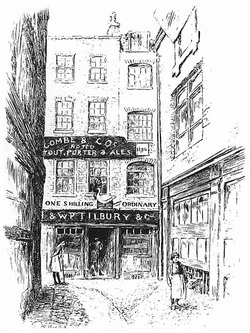A Brief History of Freemasonry

The origins of Freemasonry are shrouded in history and romanticism. The earliest document regarding Masonry, and the introduction of certain "speculative" ideas is the "Regius Manuscript" or "Halliwell Poem," which has been estimated to have been written around 1390. The Poem begins with the history of the "craft" of Masonry, Euclid being the originator of geometry, through "divers lands" all the way to England. It then list points for both the Masters of the Craft as well as the Laborers on proper moral behavior as well as the operation of working on a building site.
Between 1390 and 1717, we have very limited references to measure the birth and growth of "Speculative Masonry." For example we know that Masonic Lodges existed in Scotland in the 16th Century, the Second Schaw Statutes (1599) speaks of the Lodge of Kilwinning, one of the oldest lodges in the world which predates the organization of any Grand Lodge and is still in existence. Or the initiation of Elias Ashmole as a purely "Speculative Mason."
In 1666, the city of London had burned for three days; destroying the city within the Roman City Wall, 13,200 homes, 87 parish churches, St. Paul's Cathedral, and most of the city's governmental buildings. Masons from around the country came to the city to rebuild and formed various lodges for practical reasons of distributing the work load and making sure administration duties were completed, these lodges were named for the various taverns that they met in for their meetings. By 1717 the city had been rebuilt and most of the lodges had been disbanded. Four remaining lodges; the Goose and Gridiron, the Apple Tree, the Crown, and the Rummer and Grapes, met and joined together to reestablish ancient customs and try to rejuvenate Masonry in the London area. These four lodges organized the first Grand Lodge, the Grand Lodge of London and Westminster which would become the Grand Lodge of England. This is the crucible event in "Speculative Masonry."
From this Grand Lodge, subordinate lodges began to form, competing Grand Lodges formed, and Masonry soon became the new, cool thing for everyone around the world to join. By the 1730's Masonry came to the "New World" in Pennsylvania. Quickly, each colony had lodges and had formed a Grand Lodge. As the United States grew and expanded West, Masonry went with it. In 1858 Masonry finally found the Utah Territory and has been part of Utah history ever since.
Between 1390 and 1717, we have very limited references to measure the birth and growth of "Speculative Masonry." For example we know that Masonic Lodges existed in Scotland in the 16th Century, the Second Schaw Statutes (1599) speaks of the Lodge of Kilwinning, one of the oldest lodges in the world which predates the organization of any Grand Lodge and is still in existence. Or the initiation of Elias Ashmole as a purely "Speculative Mason."
In 1666, the city of London had burned for three days; destroying the city within the Roman City Wall, 13,200 homes, 87 parish churches, St. Paul's Cathedral, and most of the city's governmental buildings. Masons from around the country came to the city to rebuild and formed various lodges for practical reasons of distributing the work load and making sure administration duties were completed, these lodges were named for the various taverns that they met in for their meetings. By 1717 the city had been rebuilt and most of the lodges had been disbanded. Four remaining lodges; the Goose and Gridiron, the Apple Tree, the Crown, and the Rummer and Grapes, met and joined together to reestablish ancient customs and try to rejuvenate Masonry in the London area. These four lodges organized the first Grand Lodge, the Grand Lodge of London and Westminster which would become the Grand Lodge of England. This is the crucible event in "Speculative Masonry."
From this Grand Lodge, subordinate lodges began to form, competing Grand Lodges formed, and Masonry soon became the new, cool thing for everyone around the world to join. By the 1730's Masonry came to the "New World" in Pennsylvania. Quickly, each colony had lodges and had formed a Grand Lodge. As the United States grew and expanded West, Masonry went with it. In 1858 Masonry finally found the Utah Territory and has been part of Utah history ever since.
